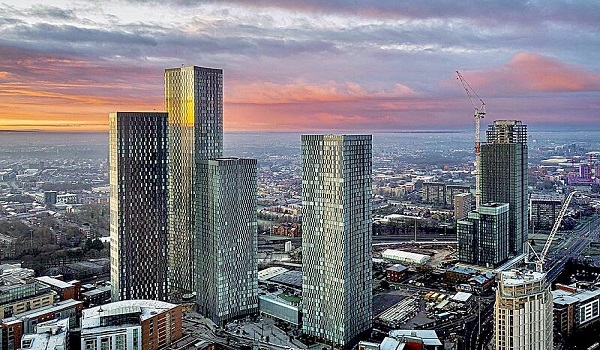Deansgate England

Deansgate is a major road in England that runs through the center of Manchester. Deansgate England is part of the A56. It goes through the western part of the city center in a mostly straight line from north to south. It is the largest road in the city center, over a mile long.
History:
Deansgate is one of the oldest streets in the city. It started at the River Medlock, near the Roman fort of Mamucium, with a ford and the route to Deva (Chester). Along it were a few homes for regular people and a mansion near the Hilton Hotel. An old name for part of it was Aldport Lane. Castlefield was known as Aldport in Saxon times. The area was mostly farmland until the 1730s when a quay on the river caused people to move there.
The road is named after the long-lost River Dene. The river may have moved along the Hanging Ditch, which runs from the street's northern end to the southern end. "Gate" comes from the Norse word gata, which means "way."
By the late 1800s, Deansgate England had a lot of different uses. In the north, there were shops and big office buildings; in the south, there were houses and a working-class area around St. John's Church (St. John Street stayed upper middle class). Beginning in 1869, the Wood Street Mission started to deal with social issues. Today, it does so in a very different way.
From Peter Street going south, the Great Northern and Manchester South Junction Railways' viaducts took up most of the eastern side. Below Deansgate, the Rochdale Canal crossed to connect with the other canals beyond. The Manchester Evening News newspaper's main building was on Deansgate in the late 20th century. Part of the Spinningfields development has since moved in to take its place.
Transport:
Today, the National Rail and Manchester Metrolink stop and several bus lines, including the Metroshuttle services, are the main ways to get around on Deansgate.
On July 20, 1849, the Manchester, South Junction, and Altrincham Railway opened Deansgate Station in Knott Mill. There is a Metrolink link between it and the Deansgate-Castlefield stop.
During the first part of the 20th century, Manchester Corporation Tramways ran trams along Deansgate. After that, many bus lines used the road. In the 1970s, many bus lines were changed or split into two services that ended in the city's heart. Streets nearby, like King Street, were made pedestrian-only.
People wanted to stop driving on Deansgate and make it a pedestrian-only street in 2009. The calls came in because of roadworks that shut down parts of Deansgate.
In 2019, Extinction Rebellion set up tents from St. Mary's Gate to John Dalton Street and held talks about climate change, healthy living, and resistance for four days. This brought up calls for it to be made a walking area again.
In 2022, bike tracks were made wider, and at the corner of Blackfriars Street and Deansgate, a bus lane opened for buses, cabs, and bikes going south. To keep things safe, there will only be one way to go south from Bridge Street to Quay Street.
Three "free bus" lines go around the city center. All three of them stop at Deansgate.
Things that happen:
Sports events have occurred in the city center's Deansgate, a long, straight street. In 2006, A1 Racing cars came to the city to start the A1 Grand Prix. Deansgate was part of their route. A huge crowd gathered to watch while Jenson Button was driving a McLaren MP4-23 along Deansgate as part of the Vodafone Vip Live Manchester event in August 2011.
Deansgate England, which had a 150-meter sprint track, was the first Great City Games site in 2001. The event takes place every year on the Great Manchester Run weekend in the middle of May. In 2009, Usain Bolt set a world record for the 150-meter straight. In 2010, Tyson Gay set a record for the 200-meter straight.
Conclusion:
Now, Deansgate is the center of many of Manchester's public events, like Gay Pride, Manchester Day parades, and Manchester United, which won the triple. Jenson Button sped up it in a Formula One car, and Usain Bolt broke the world record for speed.
Provident Housing prelaunch apartment is Provident Deansgate.
| Call | Enquiry |


